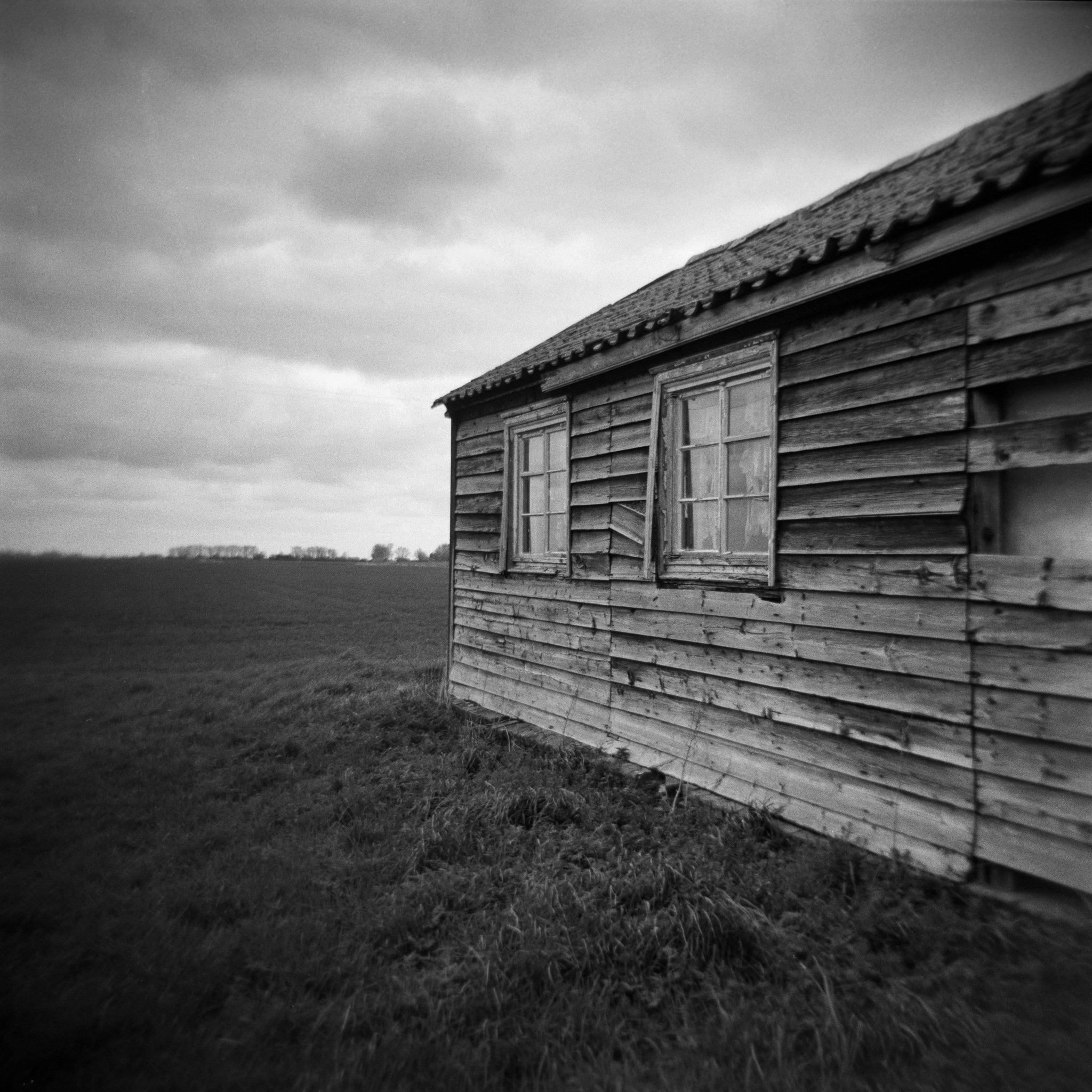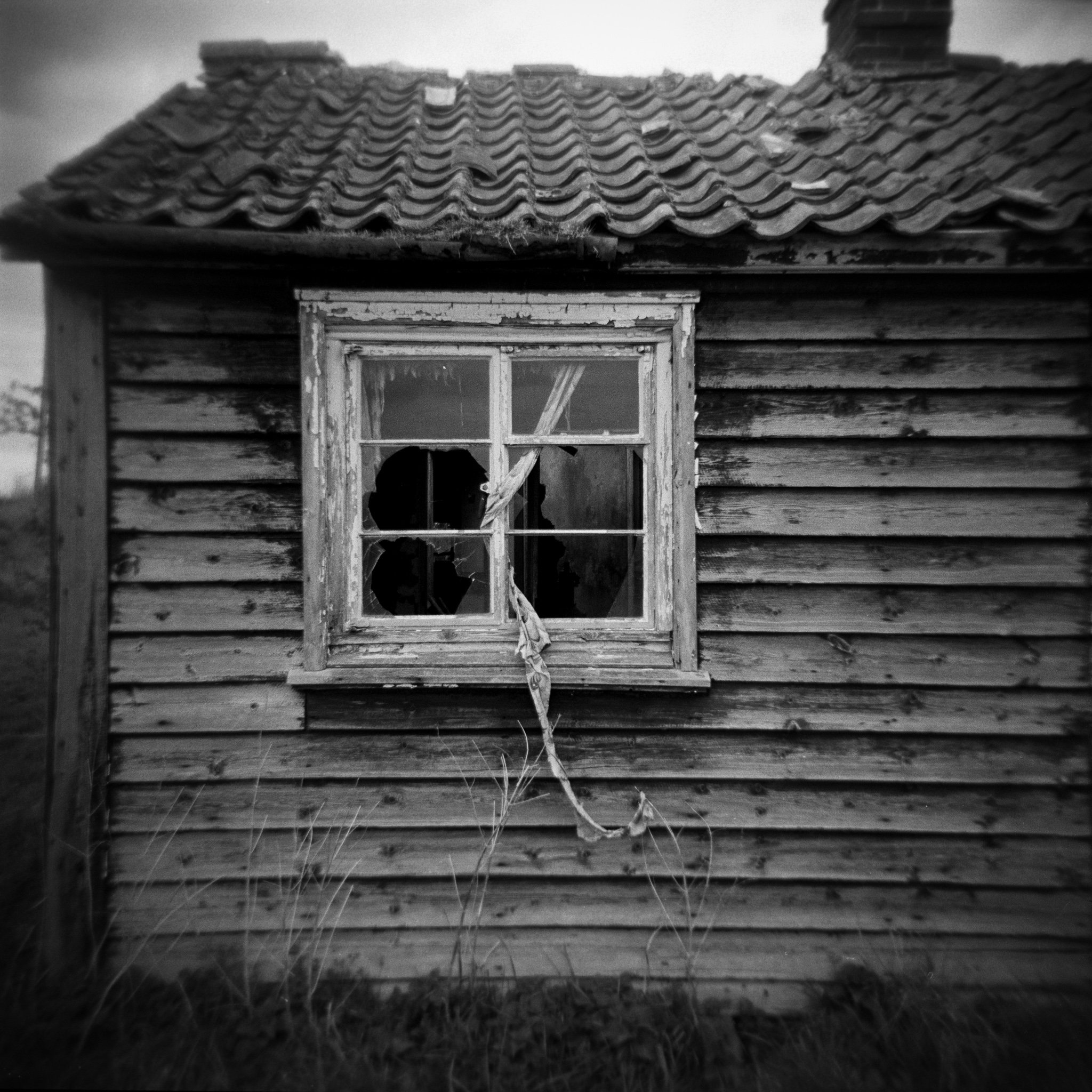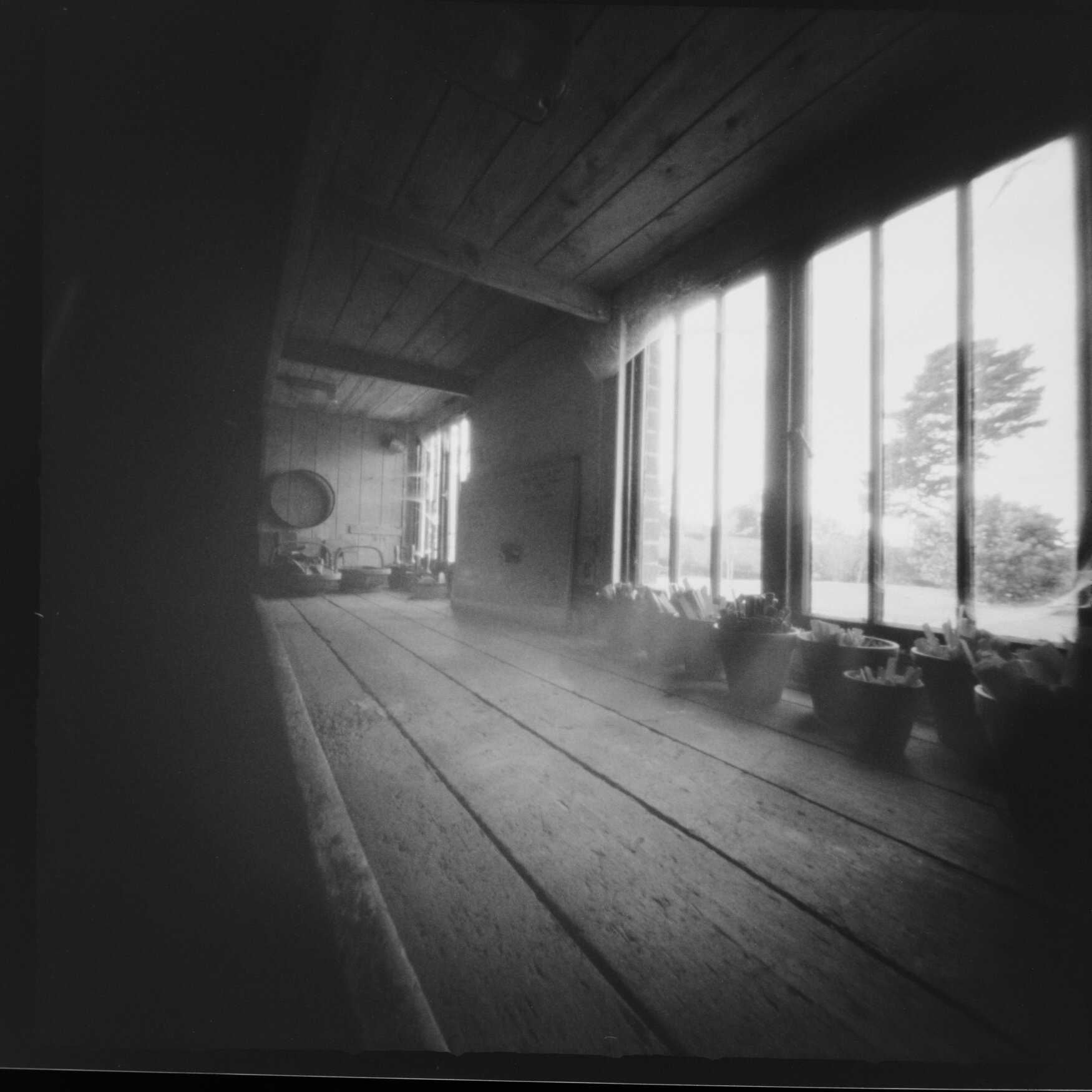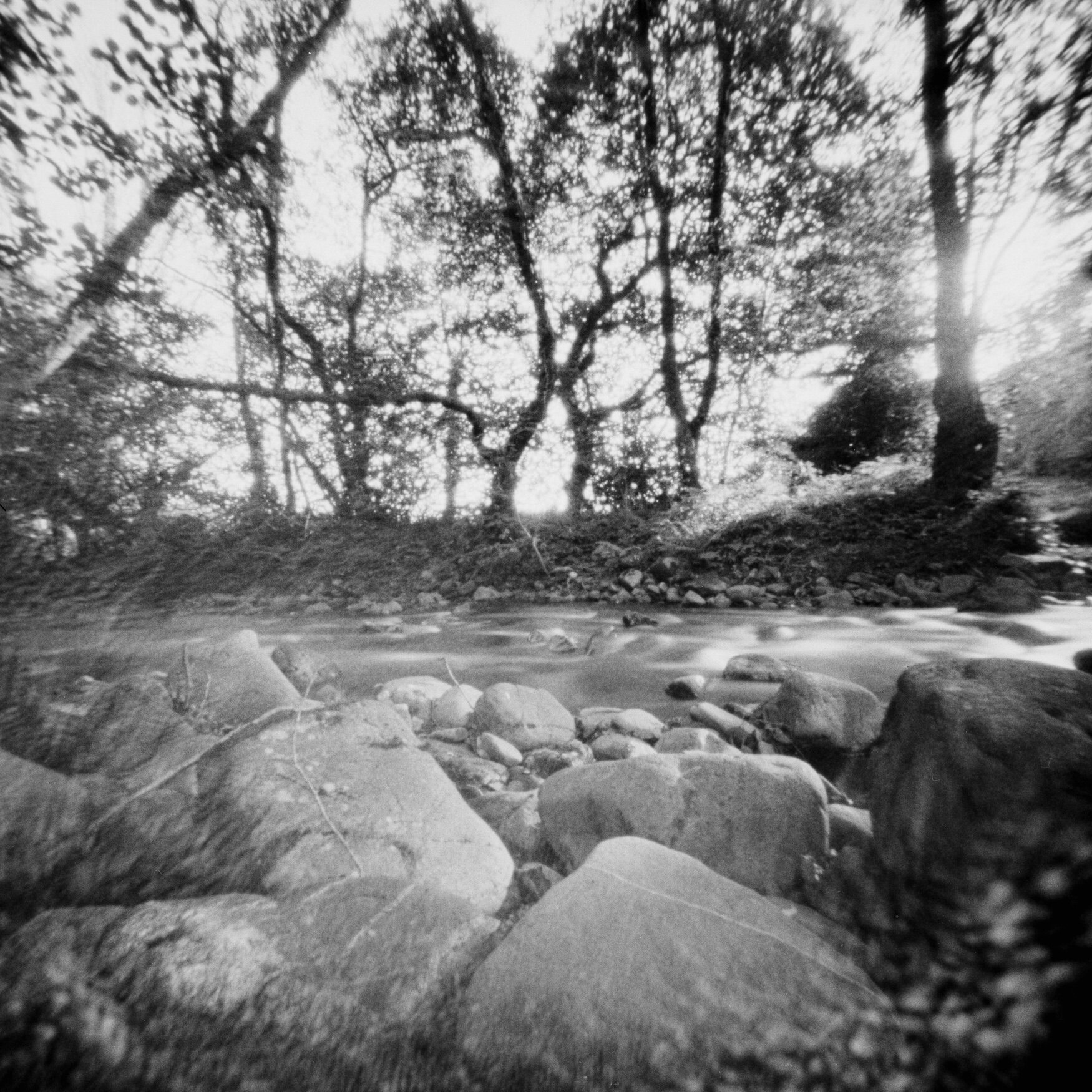One of my photographic resolutions for 2022 was to spend less money on gear, focusing my attentions instead on education to better my skills. During the various Covid lockdowns in 2020 and 2021 I’d already begun to look beyond digital photography, using a selection of pinhole cameras to explore this simplest of photographic genres. While I love the process of taking pinhole photos, and the end results too, it’s proved to be a very solitary experience pursuing such a niche genre. To rectify this I’ve sought out other pinhole photographers who offer workshops and this led me to Andrew Bartram.
Andrew is a film photographer based in the Cambridgeshire Fens who has recently started offering very reasonably priced (at the time of writing £65 for one day and £100 for two) workshops on photography and darkroom developing/printing. I also knew of him as 50% of the presenting team on the Lensless Podcast so this seemed like a excellent way to continue my pinhole education. Doing one of Andrew’s two day workshops would bring me the chance to go out and shoot with someone who shared my interest in lensless photography, as an opportunity to dip my toes into the realm of home developing and printing. I chose to focus on black and white film but for a small supplement (to cover the additional costs) Andrew also offers colour development and printing.
In early April I headed over to Andrew’s home in Cambridgeshire for the first of two days. We began with a chat, discussing our plans for the workshop. Our conversation also covered photographers whose work Andrew particularly admires, the intricacies of exposure metering, particularly in high contrast settings, and some of the places we’d visit shoot.
I found the remains of a windowsill on which to balance my Ondu pinhole camera to photograph the interior of this decaying room
When we were ready we headed out into the Fens to take some photos. I’d brought my Ondu 6x6 pinhole camera along, but also threw in a Holga with a plastic lens I’d recently bought on eBay for good measure. Andrew went lens free too, with his Harman Titan 4x5 pinhole camera. We visited some of his favourite Fenland locations, looking for simple compositions among the flat lands and poker straight waterways. You’re never going to find dramatic mountainous vistas in Cambridgeshire, but this otherworldly landscape has a uniquely minimalist charm. One particular highlight for me was a decaying wooden cottage which sits alongside Forty Foot Drain. The textures of decay are irresistible to most photographers and I was so taken with the possibilities of this dilapidated old building I logged the location on Google Maps to return again at a later date!
The Holga image I chose to print
With two rolls of film exposed we headed back to Andrew’s house for lunch and a crash course on how to load film onto a spiral, ready to go in the developing tank. I’d tried my hand at developing 4x5 film a few times before, but this was mainly in order to avoid bankrupting myself. Unlike roll film, sending sheet film away to be commercially developed is eye wateringly expensive (around £3 per sheet last time I checked) so this was the only way to go when I got my large format pinhole camera. I’d never tried developing 120 film though - largely because I was too scared too scared of messing up the business of getting the film into the spiral reel.
Andrew started me off practising with a roll of sacrificed film and a Paterson spiral - the type most commonly used for home developing. I didn’t find it particularly natural but had an ‘aha’ moment when instead I tried a Hewes stainless steel spiral. This seemed much more intuitive for me. After a few more practice runs with my eyes closed it was time to load up my own film in the darkroom, ready to be developed. Andrew told me that most of his students chicken out of doing this themselves during the workshop but I decided to go for it, figuring that if I made a complete hash of things Andrew would at least be able to leap in and untangle things for me! Miraculously, I loaded both rolls in double quick time - that meant I was either a natural or it was beginner’s luck - my money was firmly on the latter….
Preparing to develop…
With both rolls of film loaded up it was time to develop them. We used Ilford ID11 developer - a chemical I’d tried previously on my 4x5 negatives. On those occasions I’d successfully revealed some photos, but was disappointed to find my negatives covered in lots (and I mean lots!) of tiny dots. I hadn’t been able to figure out why this was (even when using deionised water instead of the hard water from our taps) so until this point I’d more of less given up trying. Andrew’s suggestion was to ditch my stop bath and use water instead because he thought perhaps the stop bath might be shocking the film. This seemed an elegantly simple solution, not to mention cheaper too! To my relief the developed rolls revealed 24 photos, all pretty well exposed so I finished the day a happy bunny. Even my Holga pics looked great, proving the £21 I’d spent buying the camera on eBay hadn’t been a waste. The only fly in the ointment was a mark on the first negative on each roll where I’d clipped that end of the roll to the spiral. This was a useful learning experience though, and easily rectified by loading the film from the other end next time.
My negatives contained pictures!
All in all, day 1 of the workshop had been a big success. It was great to go out pinholing with a fellow enthusiast and I’d overcome my fear of home developing. Next step printing, but first my negatives needed to dry and I needed a good night’s sleep!
By the time I reached Andrew’s house on day 2 I’d already taken the plunge and ordered a Hewes spiral and a stainless steel developing tank online - so convinced was I that home developing was something I wished to pursue. So much for not spending money on gear in 2022!
~ ~ ~
The following morning…
Day 2 began with a tour of Andrew’s darkroom and he carefully explained about the equipment within and how it worked. I’m pretty certain I exhibited a glazed look at times, especially once we got onto the mathematics relating to using the enlarger and how long the photographic paper would need to be exposed to the light. Fortunately there was no end of course exam to worry about - just as well as I’m pretty sure I would have failed spectacularly! If you’ve never printed from negatives before, or even considered how it’s done, there’s a lot of information to take in. Andrew was incredibly patient though, explaining the principles clearly, so if I ever have the chance to do this at home I’m pretty sure I could figure it out with the help of a quick refresher.
Our task before lunch was to make contact sheets of my negatives, so I could choose which photos to print later. Two of them jumped out at me immediately - one from the Holga and a second from the Ondu. Starting with the Holga image we made some test strips to figure out exposure times and decide on choice of coloured contrast filters. Here I relied heavily on Andrew’s huge experience. He instinctively had a good idea what would work, which made the process much quicker than if I’d had to take the lead.
My contact sheets
After lunch we set about making prints of my two photos. We made three or four copies of each one until we had a pleasing result. Making tweaks to the contrast filters and exposure times resulted in a basic print that looked good and then we began on the principles of dodging and burning. This is the process of selectively exposing the photographic paper to more light to brighten them, or depriving areas of light to darken chosen areas.
At times this seemed a little counterintuitive to me. I’m a person who likes simple rules to remember things by - for instance, when I began getting into photography my way of remembering the effect of different apertures on depth of field related to their f numbers. An aperture with a large f number (f16 for instance) equalled lots of my photo in focus, while a small f number resulted in very little in focus. I didn’t need to understand the complexities of the maths if the rule worked!
I’m this situation I remembered what to do by knowing that adding shadow for the surface of the paper below my hands made the end result lighter and vice versa. Andrew seemed perplexed by my logic, but it made sense to me!
The final version of my two prints
Actually applying the dodging and burning to the right areas of the image was another unexpected challenge. I like to think I’m good with my hands. As a professional musician I’ve developed my fine motor control from decades of practising, but here I failed spectacularly! I spent many of my early years playing with Lego and later doing hours and hours of recorder practice, but sadly this didn’t help me coordinate my movements precisely enough for dodging and burning. Evidently I should have spent more of my childhood practising making puppet shadows to prepare - if only I’d known I was going to be doing lots of film photography later in life!
My pinhole image from the decaying cottage, scanned into digital form
Despite the challenges of dodging and burning I ultimately ended the day with a pair of prints which make me smile. Yes, I had lots of help from Andrew in making them, but as a complete darkroom novice they gave me a great sense of achievement.
So will I continue my adventures in the darkroom? Yes, and no. Darkroom printing isn’t yet destined to be part of my plans. I love the idea of printing at home, but the truth is my working life just doesn’t allow enough time to make that possible. My current hybrid process of developing, scanning, post processing in Lightroom (dodging and burning) before printing with an inkjet printer is something that can be done around my work in short bursts. Never say never though - who knows what may be possible come retirement!
Home developing is a different matter though… Having realised how straightforward a process it can be I’ll definitely continue practising the skills I’ve learnt from Andrew. There’s a definite appeal to being able to turn things around more swiftly and I can see being able to take control of the development process to get the best out of my negatives will be a real plus. Add in the frisson of excitement when you first pull the negatives from the developing tank and see they contain real photos and I’m hooked! For now I’ll continue sending my colour films out for development, but who knows, I may yet book another day with Andrew to try my hand at colour processing too!
My complete set of contact sheets and prints from the two day workshop
Two months later….
A couple of months on from my workshop with Andrew I’m pleased to say home film developing has become a regular occurrence. My first attempt had mixed reviews, largely because I made a mess of loading up my spiral. A couple of loops of film stuck together so I lost a handful of frames. Fortunately I’d been out and shot some photos for the occasion which were easily replicated if it all went horribly wrong so I wasn’t devastated by the loss. Aside from this, the surviving photos were fine and I made sure to practise loading with a sacrificial roll of Fomapan film before I tried again.
Aside from a metal spiral and tank I made one other purchase - a length of blackout material. Our downstairs toilet is windowless so this is all I need to seal the light leaks around the door frame and make the space completely dark - a much easier environment in which to load up film than in a dark bag. I’ve also followed Andrew’s advice and done away with my stop bath, using water instead. Even with our hard tap water that has stopped the problems I had previously with white dots on my negatives, and I simply use deionised water for my final rinse to avoid watermarks.
I’m quickly coming to love the methodical process of develop, stop and fix at the kitchen sink (usually to an accompaniment of music - anything from Brahms Symphonies to Robbie Williams!) and I get the satisfaction of knowing each roll of film now costs me no more than about £1.50 to develop, compared to the £7 I paid previously. That’s a very handy saving with my prolific film habit! I will of course continue to send occasional rolls of colour film away for developing but in every other respect I’m a convert!
If you’re thinking about taking your first steps into developing and printing I can’t recommend Andrew’s workshops enough. It was wonderful to have one to one tuition at a pace that suited me and it didn’t break the bank either. Even better, I gained a new found appreciation for the Fens and I’ll be back soon to explore further.























